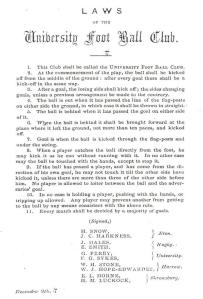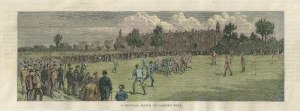20. Grown Up Boys: Football at 19th century universities
More than a problem, it probably caused nothing but enthralment, and we can imagine the football diehards putting more thought into the varying permutations of football than anything they were being taught in the lecture halls.
 The oldest recorded instance of university football was in 1303, when an Oxford student died and “it was alleged that he was killed by Irish students whilst playing the ball.” The sport was generally not encouraged. At Oxford in 1636 it was ordained that “no scholars … are to play foot-ball within the University … or in company with townsmen.” That quote indicates interaction with commoners, as had the case in 1581 of “a match played betwixt certain schollers of Cambridge and divers of Chesterton” that ended in a riot and several injuries, and had clearly violated the previous year’s declaration that no student should “play at the foot-ball but only within the precincts of their several colleges.” Not even games between different colleges were permitted because of the brawling they led to. But judging by several 17th century references, games went ahead regardless.
The oldest recorded instance of university football was in 1303, when an Oxford student died and “it was alleged that he was killed by Irish students whilst playing the ball.” The sport was generally not encouraged. At Oxford in 1636 it was ordained that “no scholars … are to play foot-ball within the University … or in company with townsmen.” That quote indicates interaction with commoners, as had the case in 1581 of “a match played betwixt certain schollers of Cambridge and divers of Chesterton” that ended in a riot and several injuries, and had clearly violated the previous year’s declaration that no student should “play at the foot-ball but only within the precincts of their several colleges.” Not even games between different colleges were permitted because of the brawling they led to. But judging by several 17th century references, games went ahead regardless.
There may have been very little footballing interaction between the public schools until well into the 19th century, mainly because they had all developed very different football traditions, but it was another story when all the old boys met up at university. This created inevitable problems. “The result was dire confusion” remembered Henry Charles Malden of a game at Cambridge in 1839. “Every man played the rules he had been accustomed to at his public school. I remember how the Eton men howled at the Rugby men for handling the ball.”
 The following year, 1840, a former Shrewsbury pupil, Edgar Montagu, went about forming “a football club at Cambridge and drawing up rules.” Little apparently became of it, but there was greater success in 1848 when two other Shrewsbury old boys, John Charles Thring and a Welshman called Henry de Winton, were accredited for calling a meeting at which “it was agreed that two men should be chosen to represent each of the public schools and two who were not public school men for the Varsity … The new rules were printed as the Cambridge Rules … and I never heard of any public school man who gave up from playing from not liking the rules.”
The following year, 1840, a former Shrewsbury pupil, Edgar Montagu, went about forming “a football club at Cambridge and drawing up rules.” Little apparently became of it, but there was greater success in 1848 when two other Shrewsbury old boys, John Charles Thring and a Welshman called Henry de Winton, were accredited for calling a meeting at which “it was agreed that two men should be chosen to represent each of the public schools and two who were not public school men for the Varsity … The new rules were printed as the Cambridge Rules … and I never heard of any public school man who gave up from playing from not liking the rules.”
Malden may have thought that, but recent research by Adrian Harvey finds no evidence of any games at Cambridge being played by any composite code until a decade and a half later, while the different public school games still went ahead on the area of parkland called Parker’s Piece, suggesting that the new rules were anything but universal. In fact football in general was still a very minor activity, and John Venn, who studied there between 1853 and 1857, once said that “I am certain that I never saw the game played.”
No copy of the 1848 rules ever survived, and we can only assume that the set discovered in Shrewsbury library, dated 1856, were an evolution of the same ones. They were clearly a simplification of the different public school games, which to the modern observer would resemble something between soccer and Australian Rules. A free kick could be claimed by catching the ball on the fly, but all running with the ball was illegal, and although the game outlawed “holding a player, pushing  with the hands or tripping up” there was not yet any specific reference to ‘shinning’, while it was made very clear, in capital letters, that “ALL charging is legal” on or off the ball. The throw-in was delivered at right angles to the pitch, as in rugby union today, teams didn’t change ends at half time but after every goal, and these were scored in between two posts with a tape for a crossbar, and no player could not touch the ball unless he had at least three defenders in front of him.
with the hands or tripping up” there was not yet any specific reference to ‘shinning’, while it was made very clear, in capital letters, that “ALL charging is legal” on or off the ball. The throw-in was delivered at right angles to the pitch, as in rugby union today, teams didn’t change ends at half time but after every goal, and these were scored in between two posts with a tape for a crossbar, and no player could not touch the ball unless he had at least three defenders in front of him.
However, the football traditions at Cambridge would go on to play a crucial role in the creation of soccer. A plaque in Parker’s Piece now commemorates how “in the 1800s students established a common set of simple football rules emphasising skill above force, which forbade catching the ball and hacking.” That did happen, but not until 1863, when rules were devised that may or may not have been a development of those of 1840, 1848 and 1856. On November 21, 1863 The Field wrote that “the first match to be played by them was fixed for yesterday,” and aside from now banning ‘shinning’ and all handling of the ball, other differences from the earlier rules included the total absence of any crossbars, the ball was kicked and not thrown back from touch, absolutely nobody could touch the ball if they were ahead of the kicker, and teams only changed ends at half time. It was these very rules that so impressed the founders of the Football Association that same year of 1863 that they were used as the blueprint for what would become soccer.
Curiously, Adrian Harvey finds that “there seems to have been relatively more interaction between players from different schools at Oxford” rather than Cambridge. But although there are stories of the trouble they had getting these matches to work, there is no evidence that Oxford students ever attempted to draw up a composite code.
 Another university where there is ample evidence of student football in this period was Edinburgh, where Alexander Fergusson’s memoirs of games in the 1840s mentioned the nasty business of having to blow up a raw pig’s bladder to make the ball. It was a common prank amongst students to, “when the bag was three quarters filled, squash the whole thing flat. The effect of the foul blast from the unsavoury interior of the ball thus forced down the throat of the unhappy blower is not to be described.”
Another university where there is ample evidence of student football in this period was Edinburgh, where Alexander Fergusson’s memoirs of games in the 1840s mentioned the nasty business of having to blow up a raw pig’s bladder to make the ball. It was a common prank amongst students to, “when the bag was three quarters filled, squash the whole thing flat. The effect of the foul blast from the unsavoury interior of the ball thus forced down the throat of the unhappy blower is not to be described.”
 A game played in March 1851 between Scottish and English members of the University of Edinburgh Foot Ball Club could almost be credited as being the first ‘international.’ But the attendance of 500 spectators was more of a hindrance than a pleasure for they “in the most unpardonable and selfish manner crowded over the grounds so that the goals and players were perfectly undistinguishable.” It is unclear what rules they played by, but there was clearly difficulty with the rules, including an incident where a Scotsman picked up the ball from the ground and claimed a free kick. “The umpire, who saw the circumstance, immediately disallowed the claim.”
A game played in March 1851 between Scottish and English members of the University of Edinburgh Foot Ball Club could almost be credited as being the first ‘international.’ But the attendance of 500 spectators was more of a hindrance than a pleasure for they “in the most unpardonable and selfish manner crowded over the grounds so that the goals and players were perfectly undistinguishable.” It is unclear what rules they played by, but there was clearly difficulty with the rules, including an incident where a Scotsman picked up the ball from the ground and claimed a free kick. “The umpire, who saw the circumstance, immediately disallowed the claim.”
Explaining such situations, Hely Hutchinson Almond, headmaster at Loretto School, recalled that “it must be said in excuse for this and other similar sins of ignorance that the only available rules were those printed for the use of Rugby School. They were very incomplete and presupposed a practical knowledge of the game.” Several schools in Edinburgh had Rugby-educated masters in the 1850s, and this led to an inclination towards that school’s game in the city, where it was written that it was played “twenty a side, and a scrum was a scrum indeed – fifteen men pushing against fifteen in a tight maul.” It was for that reason that when the English FA issued a challenge to the Scottish players in 1871, the offer was rejected. The Englishmen were told that “devotees of the ‘association’ rules will find no foemen worthy of their steel in Scotland.” North of the border, rugby was the game.
Click here to buy the book and read the whole story.
21. A QUESTION OF CLASS: 19th century football in the non-academic world

Thanks for this wonderful report. Yet another thing to mention is that almost all digital cameras arrive designed with a contact that enables pretty much of your arena to get provided by ‘zooming’ inside and out. These kinds of alterations in concentration period tend to be mirrored inside the viewfinder and also on huge screen on the back again regarding the actual camera.